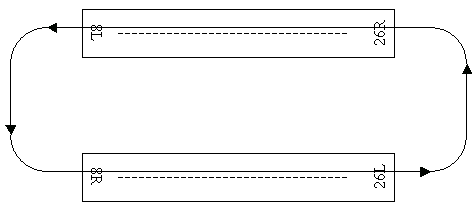| Flight Simulator Practice - Low Approach (*) The contents on this page is for flying in a PC flight simulator. It is not intended for the real flight training. |
| Low Approach for Landing Practice It is actually very difficult to land exactly on the runway centerline in the PC flight simulator. Probably it is more difficult than doing it in a real airplane. Why? I thought about it before, and the answer was as follows. Let's say you are flying a real airplane, and turning toward the runway for landing. Since you re not on the extension of the runway centerline, the runway is left or right of the axis of your airplane. If you look at the runway from that position, do you fix your head parallel to the airplane's axis and see the runway off center of your view? You will not do that. You will turn your head toward the runway and look at the runway at the center of your view. If you turn your head toward the runway, the runway will look like a trapezoid even if your airplane is not parallel to the runway. Therefore, you can know that the airplane came to the extension of the runway centerline by the shape of the runway. However, in the PC flight simulator, the runway does not necessarily look like a trapezoid when the airplane comes to the extension of the runway centerline because in the PC flight simulator, your head is fixed parallel to the axis of the centerline. Even when the airplane is exactly on the extension of the runway centerline, the runway does not look like a trapezoid unless the heading of the airplane is parallel to the runway. The following screenshots are taken by YSFLIGHT when the airplane is on the extension of the runway centerline. In the screenshot on the left, the runway does not appear to be a trapezoid even though the airplane is on the extension of the runway centerline. At the same position, if I turn the head (virtually) toward the runway, the runway appears to be a trapezoid as shown in the screenshot on the right.
Once your airplane comes on the extension of the runway centerline, and the heading becomes parallel to the runway, you can slide into the runway (at least above the runway if you don't crash before the runway) just by maintaining the trapezoid of the runway. However, it is easier said than done. So, for those who cannot land in the flight simulator, I'd like to recommend to practice low approaches. To land an airplane, one thing you need to do is flying parallel to the runway. You need to maintain an approach speed, descend rate, and touch down past the runway number, but practicing them all together could be too much. In fact, in a real flight training, a student pilot practices ground reference maneuvers, before practicing landing approach. The ground reference maneuvers include turning around a reference point on the ground while maintaining the distance from the reference point, flying parallel to a highway, and drawing a rectangular flight path. Such maneuvers should be done at 500ft above ground. Among them, flying parallel to the highway is for practicing landing approach to the runway, and drawing a rectangular flight path is for making a traffic pattern. (I don't have an instructor license, but my instructor told me so.) The reason why not using a real runway is because the real runway is a public facility, and other airplanes also use it. Letting a student pilot who cannot make a good enough traffic pattern into the airport vicinity is not safe. However, we don't need to care about other airplanes in the PC flight simulator, and we can practice such ground reference maneuvers over the airfield. So, I recommend you to practice flying low altitude, like 100ft to 300ft over the ground, parallel to the runway. It is called a low approach. You should choose an airport that has two parallel runways. In YSFLIGHT, Heathrow 27/9 or Honolulu International 8/26 in Hawaii is recommended. First, don't care much about the airspeed, just keep it fast enough to avoid stall, after take-off and approach toward a runway. Then fly right above the runway parallel to the runway and pass the runway. Then climb up to 1000 to 2000ft, and make a 180 degree turn and make another approach to the other parallel runway. Repeat this practice until you never fail to fly parallel to the runway. You can download an example flight record for YSFLIGHT from the following link. [Download sample flight record file for YSFLIGHT]
If you become good enough and never fail to fly parallel to the runway, then lower the landing gear and flaps (air brakes if necessary), and maintain approach speed, and do the same thing. Finally, you will be able to reduce power to idle over the runway, and pull the nose up and land by the main landing gears. Of course, you are not likely to be allowed do the same thing in a real airplane. But, you can take advantage of the freedom of the flight simulator. I would write follow ups when I have time.
|
| Comments are welcome.
Send E-Mail to:
|


